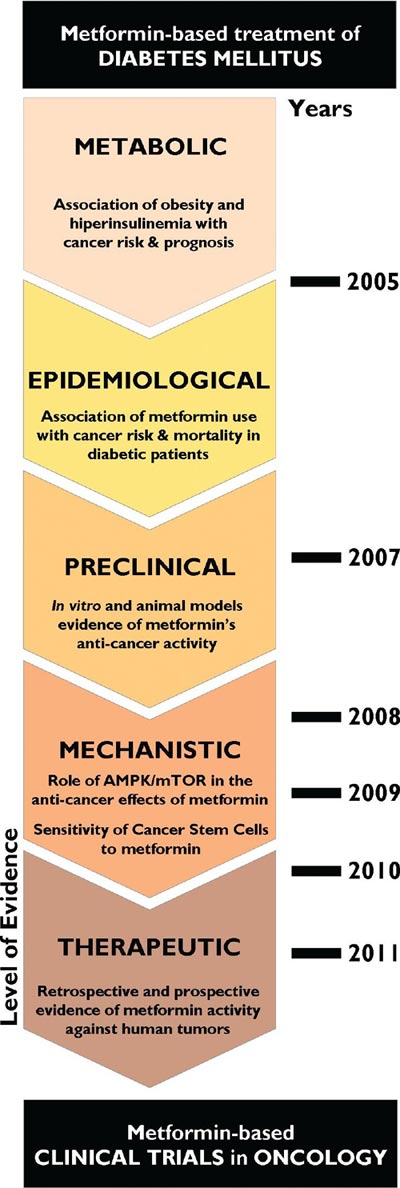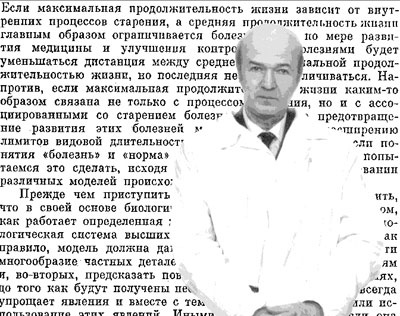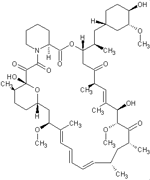Posted September 30, 2012: by Bill Sardi
It is not surprising to learn that Big Pharma has shown no interest in what may become the world’s first proven cancer prevention pill. If big profits aren’t promised, pharmaceutical companies predictably pass on such a development.
The pill is a relatively safe FDA-approved generic drug, prescribed millions of times to help control diabetes, and it costs maybe 10-cents a day. But what is surprising is that public health authorities appear to be remiss in announcing this breakthrough. They are the agency in society commissioned to address important public health issues such as this.
Data has been accumulating for 5 years now showing metformin (Glucophage), an anti-diabetic drug, dramatically reduces the risk for cancer and prolongs life among patients who are battling cancer.

Graphic: courtesy Oncotarget
The data does not solely involve experiments with laboratory mice that often don’t translate to humans. The data involves human studies.
Remember the big to-do that the New York Times created in 1998 over a cancer drug that a Nobel Prize winner said would “cure cancer in two years?” (That quotation was later denied.) On the day that news story was released the stock price soared for the company making the developmental drug then said to cure cancer. But for metformin, a drug first approved by the FDA in 1958, there is little fanfare. Its patent expired years ago and it is a generic drug with low profitability. A quick check on Google shows just six news outlets online are distributing the story. Of the 7 billion people on the planet, how many will learn of this?
If this were some potential new blockbuster drug, the National Institutes of Health would be grandstanding it in a press release and even a press conference. Instead it is a news agency — in this instance Bloomberg News — who is independently breaking the story (let’s hear it for a free press). Bloomberg reporters quote a researcher who says drug companies passed up sponsorship of studies involving metformin and cancer when they realized their patents would expire before the research study was completed.
Frustratingly, science is moving too slowly towards adoption of such a pill. It wants to conduct another decade of research before drawing any conclusions. A number of large long-term studies are underway but not scheduled to report any data till 2016-2017.
Cancer patients haven’t ten years to wait. Whether oncologists begin to prescribe it is another question. It isn’t being heralded in oncology journals. The American Cancer Society website is ignoring this breakthrough as well.
Just how convincing is the currently available evidence? First, diabetics have a much higher incidence of cancer. So it should not be surprising that an anti-diabetic drug quells cancer.
Second, the risk of subsequent cancer diagnosis was significantly reduced among patients with adult-onset diabetes who took metformin. The most compliant patients were more protected against cancer than those who failed to follow their pill regimen. Another study shows an impressive 56% relative reduction in the risk for breast cancer among diabetics taking metformin compared to other anti-diabetic drugs.
Researchers recently explored a database of thousands of diabetic subjects in Tayside, Scotland. Cancer was diagnosed among 7.3% of 4.085 metformin users and 11.6% of 4,085 non-metformin users. Metformin users tended to develop cancer almost a year later than non-users.
The study that has gained much attention involves metformin among patients with pancreatic cancer, a dire form of cancer where survival following diagnosis is usually no greater than 1-2 years. Metformin produced a significant 60% relative reduction in ongoing risk for pancreatic cancer among patients already diagnosed with the disease.
Another compelling report published in 2009 showed that among 2,529 patients who underwent chemotherapy for early-stage breast cancer, 24% of the patients who were taking metformin experienced a “complete response” (cure) compared to just 8% in the non-metformin group.
As encouraging as these studies are, not all show metformin is beneficial in preventing cancer.
Metformin is a molecule found in the French lilac (botanical name: Galega officinalis), and is now synthetically produced. Metformin is in a class by itself when it comes to anti-diabetic drugs. It is the only anti-diabetic medication that does not induce weight gain.
While it is clear that a renaissance is underway in the use of metformin, this time for cancer, it is sad to realize modern medicine could have leaped at a decades- earlier opportunity to discover metformin’s anti-cancer potential.
In the early 1970s Professor Vladimir Dilman pioneered the idea of molecules called “biguanides’ as an anti-cancer drug as well as anti-aging pill. Using phenformin, a close cousin to metformin, Dilman achieved positive results, halting a metabolic decline in immunity among post-operative (mastectomy) breast cancer patients.
In animals Professor Dilman was able to extend the lifespan of mice by 23% and reduced tumor incidence by 80% employing a relatively low dose of phenformin. This is better than current life extension studies achieved with laboratory mice using resveratrol, a widely heralded anti-aging molecule. It is clear what Dilman was discovering was greater than a cancer cure– it was a true anti-aging pill! Phenformin was called a “geroprotector” just over a decade ago.
At about the same time these studies by Vladimir Dilman and colleagues were being conducted at the N.N. Petrov Research Institute of Oncology, St. Petersburg, Russia, The Society of Actuaries (insurance underwriters) was being privately briefed on the development of an anti-aging pill. A report of this meeting shows the topic of discussion was the scientific possibility of extending life up to 250 years.
That report went on to proclaim that that such a discovery was “not ready for widespread application in the field of medicine.” It is clear that the insurance industry squelched the idea of an anti-aging pill because it would put them out of business. How do you sell life insurance to a guy at age 30 when he’s going to live 250 years?

Professor Vladimir Dilman (1925-1994)
Dilman’s discoveries at the Petrov Research Institute would go ignored, not to be implemented. Even now, while the promise of a true cancer cure is tantalizing, the prospect of an even greater discovery is not being mentioned – that of man’s impossible dream — anti-aging pill.
Surprisingly, metformin may not be the only molecule that can perform like this.
Metformin is often mentioned along with two other molecules, rapamycin, a soil organism used as an immunosuppressive drug to treat rejection of transplanted organs, and resveratrol, a red wine molecule, as the most promising anti-aging agents. These three molecules are known to mimic some of the biological effects of a calorie-restricted diet.
While investigators uncover the key biological mechanisms that produce the anti-cancer effects of metformin, they fail to recognize that even these mechanisms are a result of something that goes unrecognized. These biological mechanisms are not the driver behind the drug, they are the way the effectiveness of the drug is measured. What IS the biological driver is the ability of metformin to chelate (key-late) or bind to unbound iron. It is accumulated iron that drives up blood sugar levels. Blood letting, which removes excess iron from the blood circulation, unequivocally resolves insulin resistance among diabetics and is even used in the treatment of cancer.
The very wide array of side effects produced by metformin and rapamycin may be due to their iron chelating properties.
Metformin has actually been used experimentally to counter the harsh effects of a toxic cancer drug (doxorubicin) that releases iron and can be damaging to the heart during treatment. In the animal lab, metformin prevents damage to the heart during chemotherapy due to iron-induced oxidation.
Researchers have said that metformin’s primary action against cancer is its ability to halt the immortalization of cancer cells. Cancer cells don’t replicate and then die off, they resist all efforts to kill them, what is called treatment resistance.
One of the recognized mechanisms of metformin is its ability to induce cellular senescence. Cellular senescence is the phenomenon by which normal cells lose their ability to divide, normally after about 50 cell divisions in a lab dish. Therefore, senescent cells cannot replicate and produce tumors. Like metformin, resveratrol also induces cellular senescence.
Another desirable gene target for both metformin and resveratrol is known as Target of Rapamycin or mTOR. High concentrations of resveratrol are required to significantly inhibit mTOR at doses that approach toxic levels. Rapamycin, the other oft-mentioned anti-aging molecule, actually suppresses cell senescence. Though this should not be considered a negative property as rapamycin is attempting to return the cell to a youthful state.
A chart has been created at the end of this report to help compare these three molecules, metformin, rapamycin and resveratrol. The main point here is that there may be more available alternatives to metformin, which requires a doctor’s prescription. Doctors are not likely to begin prescribing metformin to prevent cancer, let alone slow aging. Meanwhile, resveratrol is widely available as a dietary supplement. The medical profession will be quick to label resveratrol as an unproven remedy, but actually all existing cancer treatments have already been disproven, leaving cancer patients to search for available alternatives.
It is well established that blood serum and tissue concentrations of copper are greatly increased in various malignancies. Resveratrol works by selectively cleaving to or releasing copper based upon dose.
Resveratrol as a fat-soluble molecule is able to be transported across cell membranes and enter the internal workings of cells. In high dose concentration, resveratrol will cleave to DNA in the cell nucleus and induce DNA breakage, killing the cancer cell.
Resveratrol as a copper chelator appears to be superior to zinc or iron chelators in regard to their cancer cell-killing properties. Because cancer cells rely upon copper for growth and resveratrol targets copper, this explains why resveratrol destroys cancer cells but not healthy cells.
The problem with resveratrol’s pro-oxidant cancer-killing action, even though resveratrol targets cancer cells and not healthy cells, is that given in high doses this molecule is concentrated in the kidneys where it is excreted and becomes so toxic it can induce kidney failure. This was shown in a controlled study conducted among terminal multiple myeloma (bone-marrow) cancer patients who were given 5000 mg of resveratrol and rapidly experienced kidney failure. Modest doses may be the best approach for cancer patients who are self-treating with resveratrol.
In regard to inducement of cellular senescence and inhibition of the mTOR gene, resveratrol does this, but at dose concentrations that are toxic. At low-dose concentration, resveratrol is an antioxidant and at high-dose concentration it promotes oxidation (pro-oxidant).
However, a proprietary resveratrol-based formula (Longevinex®) has been shown to totally abolish any toxicity at even the highest dose tested (2800 mg human equivalent). While this would negate any direct cancer-killing effect, this resveratrol-based formula exhibits strong ability to inhibit new blood vessel formation required for tumors to receive nutrients and grow (a six-times greater effect than plain resveratrol). It has undergone toxicity testing and exhibits no kidney toxicity in humans or animals (unpublished). It also inhibits cancer via its ability to thin the blood (clots promote the spread of cancer), inhibit inflammation, and favorably control the immune response. This resveratrol formula was also found to be the closest thing to a calorie restricted diet as evidenced by its ability to alter 677 of 831 known genes that are altered by a long-term calorie-restricted diet in laboratory mice.
Will metformin, rapamycin and resveratrol incur the same fate as phenformin? Will the public wait for their doctors to give them the go-ahead signal, or bolt for these remarkable molecules on their own? It would not be surprising to see cancer patients buy metformin online from offshore sources that ship without a prescription. Any natural medicine that even poses a threat to the $75 billion cancer drug market will likely be ignored. It is the best way scuttle any threat to the $124 billion cancer industry. If the major TV news networks, Harvard Medical School and your doctor say a promising anti-cancer agent is unproven, that is the final word on that matter. Pity the unsuspecting cancer patients.
As for an anti-aging pill, the overpopulation alarmists continue to beat their drum despite the fact the count of humans in Western Europe, Russia, Japan and North America, Brazil, China and Australia is in decline. The problem is not over-population, it is the cost of caring for a growing elderly population. In developed countries, the size of the elderly population has already surpassed that of the 12-24 age group. By dismissal of natural medicines, over-availability of cheap nutrient-poor foods, and control of health choices via insurance plans and medical school curriculums, modern medicine has protected its market and ensured there is enough disease to treat.
|
Comparison Of Three Cancer Preventive Medicines |
|||
|
Metformin |
Rapamycin |
Resveratrol |
|
| Drug classification |
Anti-diabetic Requires doctor’s Rx |
Immune suppressant (inhibits organ transplant rejection) Requires doctor’s Rx |
Nutriceutical No Rx required |
| Drug name |
Glucophage |
Sirolimus, Rapamune |
— |
| Natural origin |
French lilac |
Easter Island soil organism |
Grape skin, Knotweed |
| Molecule |  |
 |
 |
| Molecular weight |
165 Daltons |
914 Daltons |
228 Daltons |
| Induces cell senescence (no longer capable of growing and dividing) |
Yes |
Yes |
|
| Reduces cancer in humans by |
20-50% |
Unknown |
Unknown |
| Known anti-aging agent | |||
| Mechanisms | |||
| Targets AMPK enzyme | |||
| Anti-folic acid agent |
Unreported |
||
| Inhibits mTOR |
Yes |
Yes |
|
| Mineral chelator |
Iron |
Iron |
|
| Known effective dose |
0.5 to 1.0 mg |
Less than 350 mg |
|
| Cost per day |
$0.10 edrugsearch.com |
$3.74 edrugsearch.com |
$0.24 200mg /Amazon |
| Common side effects |
Diarrhea, nausea, vomiting, flatulence, asthenia, indigestion, headache, vitamin B12 deficiency (6 in 100 patients) |
Many (low dose safer) Peripheral edema, elevated blood pressure, diarrhea, abdominal pain, headache, fever, anemia, nausea, elevated cholesterol/triglycerides |
Anemia |
| Serious side effects |
Metabolic acidosis (3 in 100,00) |
Viral infections, elevated cholesterol/triglycerides, thrombocytopenia |
None reported |
| Precaution with |
Alcohol, diuretics |
Grapefruit juice, many other drugs, herbs |
Other medications |
| AMPK (AMP activated protein kinase), which induces muscles to take up glucose from the blood. mTOR = target of rapamycin |
|||
| Copyright 2012 Bill Sardi, Knowledge of Health, Inc. | |||
Posted in Cancer ; No Comments »
You must be logged in to post a comment.
11
17
52
95
14
24
237
6
56
43
10
116
15
66
105